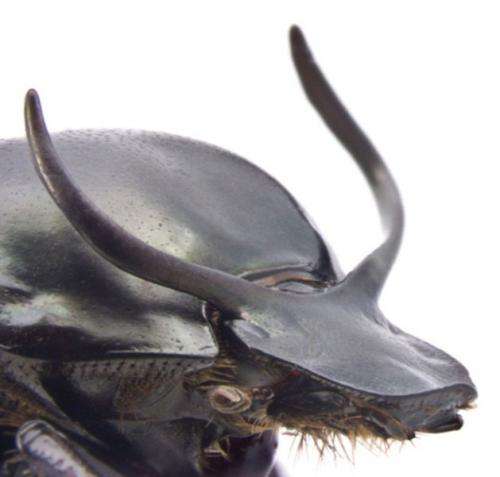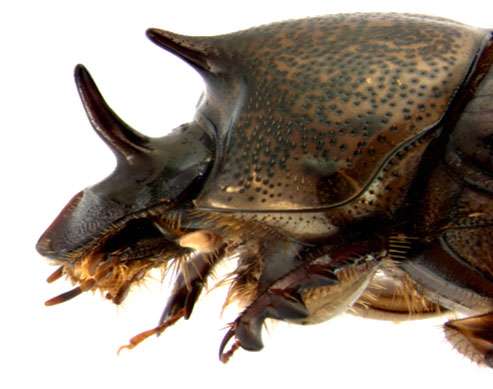Genetic mechanism, reused, makes sexes and same-sex individuals different

(Phys.org)—Indiana University biologists Teiya Kijimoto, Justen Andrews and Armin Moczek say it's time to chalk another one up for doublesex, the master regulatory gene at the terminus of the sex determination pathway that imposes female and male sexual development in fruit flies, honey bees, silk moths and wasps.
In new research just published in the Proceedings of the National Academy of Sciences that investigates the structure, expression and function of the doublesex, or dsx, gene in horned beetles, the team significantly expands on what scientists know about the range of developmental and evolutionary changes mediated by this gene.
In horned beetles, horn development is typically restricted to males, which use horns as weapons in combat for females, which lack horns.
Moczek and colleagues found that dsx regulates the sex-specific expression of horns, promoting it in males but inhibiting it in females. Things got more complicated, however, in a subset of species in which males come in two versions: Well-fed males develop into large, horned adults that fight, whereas poorly fed males grow into small hornless adults that sneak copulations. Again, Moczek and colleagues found that dsx regulates the development of horns, but this time in response to nutritional conditions rather than genetic sex.

Lastly, they identified reversed and novel functions performed by dsx in a second species that had evolved a rare reversed sexual dimorphism.
"While describing the genetic regulation of sex-differences in horned beetles, we found that this regulation has become re-used to flexibly generate alternative morphologies within a single sex, the males, and that components have undergone dramatic diversification to enable the evolution of a rare species with a reversed sexual dimorphism—females with large horns that are lacking in males of the same species," said Moczek, an associate professor in the IU College of Arts and Sciences' Department of Biology.
In one species, Onthophagus taurus, the male isoform of dsx promoted horn growth, while the female isoform of the same gene inhibited growth. Isoforms, in this case, are different forms of a protein coded for by the same gene. Those same sex-specific functions of dsx-regulating horn growth were found to be reversed as well as modified in a related horned beetle species, Onthophagus sagittarius.
Further broadening the scope of the results was the evidence that nutritional conditions may influence doublesex expression.
"This might perhaps be the most exciting part," Moczek said. "We found strong support that moves this developmental machinery that orchestrates sex-specific development into a whole new realm, that being the nutrition-dependent development of different male morphologies."
When dsx expression was examined in developing horn and non-horn tissues in large and small males and females, male isoform expression of dsx was far higher in the horn tissue of large males that experienced dramatic growth due to increased nutrition, while low in the horn tissues of small males. In females, female isoform expression of dsx remained more uniform in both tissue types. Moreover, experimental manipulation of dsx function only affected horn development in the large horned morph, but left horn development in smaller males largely intact.
Moczek said the results show that the doublesex gene is a key mediator of diversity on at least four levels: Within individuals it allows some tissue types or body regions to take on a sexual identity while others appear to remain sexually undifferentiated; among individuals of the same sex, males in this case, dsx enables the environment-dependent elaboration of traits in one male morph but not the other; across sexes it facilitates the sex-specific elaboration or inhibition of traits; and finally, across species it enables rapid evolutionary divergences in what traits get elaborated and in what sex.
"The same or very similar regulatory mechanisms are at work in a wide range of organisms, making these results widely applicable and relevant," Moczek noted. "For example, a closely related gene has the same function in nematodes, and genes with similar domains regulate sex-specific development in vertebrates."
Journal information: Proceedings of the National Academy of Sciences
Provided by Indiana University


















